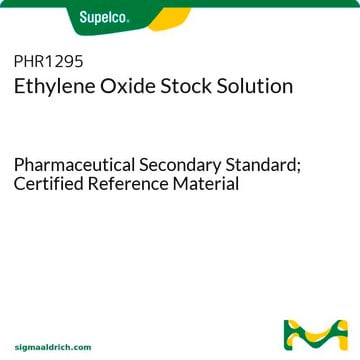30107
Hydrofluoric acid
puriss. p.a., ACS reagent, reag. ISO, reag. Ph. Eur., ≥48%
Synonyme(s) :
HF
About This Item
Produits recommandés
Qualité
ACS reagent
puriss. p.a.
Agence
reag. ISO
reag. Ph. Eur.
Densité de vapeur
1.27 (vs air)
Pression de vapeur
25 mmHg ( 20 °C)
Pureté
≥48%
Forme
liquid
Impuretés
≤0.005% hexafluorosilic acid (H2SiF6)
Résidus de calcination
≤0.0005% (as SO4)
Densité
1.15 g/mL at 25 °C (lit.)
Traces d'anions
chloride (Cl-): ≤1 mg/kg
phosphate (PO43-): ≤0.5 mg/kg
sulfate (SO42-): ≤2 mg/kg
sulfite (SO32-): ≤2 mg/kg
Traces de cations
Ag: ≤0.02 mg/kg
Al: ≤0.05 mg/kg
As: ≤0.05 mg/kg
Ba: ≤0.1 mg/kg
Be: ≤0.02 mg/kg
Bi: ≤0.1 mg/kg
Ca: ≤0.5 mg/kg
Cd: ≤0.01 mg/kg
Co: ≤0.02 mg/kg
Cr: ≤0.02 mg/kg
Cu: ≤0.02 mg/kg
Fe: ≤0.2 mg/kg
Ge: ≤0.05 mg/kg
K: ≤0.1 mg/kg
Li: ≤0.02 mg/kg
Mg: ≤0.2 mg/kg
Mn: ≤0.05 mg/kg
Mo: ≤0.05 mg/kg
Na: ≤0.2 mg/kg
Ni: ≤0.02 mg/kg
Pb: ≤0.05 mg/kg
Sr: ≤0.02 mg/kg
Ti: ≤0.1 mg/kg
Tl: ≤0.05 mg/kg
V: ≤0.05 mg/kg
Zn: ≤0.05 mg/kg
Zr: ≤0.1 mg/kg
Chaîne SMILES
[H+].[F-]
InChI
1S/FH/h1H
Clé InChI
KRHYYFGTRYWZRS-UHFFFAOYSA-N
Vous recherchez des produits similaires ? Visite Guide de comparaison des produits
Description générale
Application
- Speciation of tin ions in oxide glass containing iron oxide through solvent extraction and inductively coupled plasma atomic emission spectrometry after the decomposition utilizing ascorbic acid.: This study explores the speciation of tin ions in iron oxide-containing glass, utilizing ascorbic acid for decomposition followed by solvent extraction and analysis via inductively coupled plasma atomic emission spectrometry, highlighting a novel analytical chemistry application of hydrofluoric acid (Saijo Y et al., 2022).
- Physicochemical and morphological characterization of a glass ceramic treated with different ceramic primers and post-silanization protocols.: This paper discusses the effects of various ceramic primers and silanization protocols on the physicochemical properties and morphology of glass ceramics, contributing to analytical chemistry by elucidating the interactions and stability of treated surfaces (Moreno MBP et al., 2019).
- Effect of Surface Cleaning Regimen on Glass Ceramic Bond Strength.: Investigates the impact of different surface cleaning regimens, including the use of hydrofluoric acid, on the bond strength of glass ceramics, providing insights into optimal surface treatment methods in material science and analytical chemistry (Lapinska B et al., 2019).
Mention d'avertissement
Danger
Mentions de danger
Classification des risques
Acute Tox. 1 Dermal - Acute Tox. 2 Inhalation - Acute Tox. 2 Oral - Eye Dam. 1 - Skin Corr. 1A
Code de la classe de stockage
6.1A - Combustible acute toxic Cat. 1 and 2 / very toxic hazardous materials
Classe de danger pour l'eau (WGK)
WGK 2
Point d'éclair (°F)
Not applicable
Point d'éclair (°C)
Not applicable
Certificats d'analyse (COA)
Recherchez un Certificats d'analyse (COA) en saisissant le numéro de lot du produit. Les numéros de lot figurent sur l'étiquette du produit après les mots "Lot" ou "Batch".
Déjà en possession de ce produit ?
Retrouvez la documentation relative aux produits que vous avez récemment achetés dans la Bibliothèque de documents.
Articles
Professor Gogotsi and Dr. Shuck introduce MXenes: a promising family of two-dimensional materials with a unique combination of high conductivity, hydrophilicity, and extensive tunability.
Notre équipe de scientifiques dispose d'une expérience dans tous les secteurs de la recherche, notamment en sciences de la vie, science des matériaux, synthèse chimique, chromatographie, analyse et dans de nombreux autres domaines..
Contacter notre Service technique






